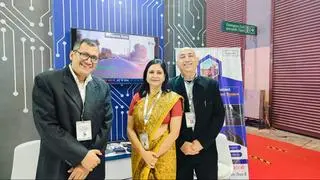Serial entrepreneurs and friends since their undergraduate days, Shailesh Vaidya and Kiran Shah had a string of successes before they had their first failure. First they began selling an invention of theirs — a take-off of their engineering college project — a machine that can tell the quality of a metal by imaging it on a computer. Then they began refurbishing old lathe machines into CNC machines for a fraction of the cost of new CNC machines.
Then the solar bug bit them.
They got into ‘solar CPV’, or Concentrator Photo-voltaic, where lenses are used to focus sunlight on a special type of solar cell (called ‘triple junction’). To get the focus right all the time, you need to keep moving the solar panels so that they keep facing the sun, with devices called ‘trackers’. CPV produces more energy than conventional PV solar; some CPV plants are known to produce twice as much.
But then, solar CPVs are expensive and the entire CPV business, globally, began to decline because conventional PV became more attractive due to a steep fall in prices of cells. For the first time in years, Shailesh and Kiran came face-to-face with failure.
“However, by then,” recounts Shailesh, “we had gained considerable experience in solar trackers.” They decided to set up a company that makes and sells tracker systems for solar plants, and thus was born Scorpius Trackers, in mid-2013.
Solar trackers are tricky. They squeeze more out of the solar cells, 20 per cent more generation for 10 per cent additional cost, but back then, they used to come with problems of their own. A typical solar plant with trackers would have a lot of motors and cables running all over, as the motors would have to be powered, not from the electricity the plant produces, but by electricity drawn from the grid. The motors and several other moving parts would require maintenance, regular lubrication, and to monitor their performance there needed to be more cables connecting with a central unit. All very messy and costly. So, few solar power developers opted for tracker systems.
Today’s trackers are a lot different and, on its part, Scorpius Trackers had a hand in the evolution of tracker technology. Armed with a ₹ 2-crore cheque from an angel investor (not named), Scorpius began to scratch around, and before long, came up with a new bearing technology that made the entire system easier to handle.
Just as Scorpius emerged on the scene, other things were happening in the solar energy industry. Mainly, solar energy prices were falling due to intense competition and oversupply of modules. Today, solar energy is traded at under ₹5 a kWhr, unthinkable in, say, 2011. Energy companies needed to extract more out of their assets. They started looking at trackers, which were becoming more attractive.
Growing turnoverShailesh and Kiran happened to be at the right place at the right time. The three-year history of Scorpius Trackers can be summed up in three turnover figures: 2014-15: ₹2.5 crore; 2015-16: ₹17 crore; 2016-17: ₹110 crore, expected, based on firm orders for 500 MW worth of systems. More could come because the company has MoUs signed for 1,250 MW.
Scorpius seems to have taken a lean approach. All but the bearing and software are outsourced. This means not only no big investments in manufacturing facilities, but also quick ramp up in tandem with orders. As such, Scorpius is keen on spreading its wings abroad. Overseas supplies are modest, but they include projects in Uganda, Japan and Palestine, but Shailesh and Kiran, both first-gen entrepreneurs, are busy launching Scorpius Trackers at every international solar meet – considerable progress from the days they would drive long distances and make cold calls on customers to sell their metal imaging devices.








Comments
Comments have to be in English, and in full sentences. They cannot be abusive or personal. Please abide by our community guidelines for posting your comments.
We have migrated to a new commenting platform. If you are already a registered user of TheHindu Businessline and logged in, you may continue to engage with our articles. If you do not have an account please register and login to post comments. Users can access their older comments by logging into their accounts on Vuukle.